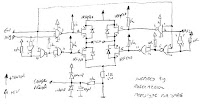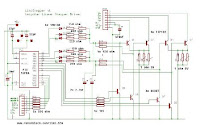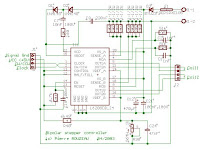This circuit will detect AC line currents of about 250 mA or more without making any electrical connections to the line. Current is detected by passing one of the AC lines through an inductive pickup (L1) made with a 1 inch diameter U-bolt wound with 800 turns of #30 - #35 magnet wire. The pickup could be made from other iron type rings or transformer cores that allows enough space to pass one of the AC lines through the center. Only one of the current carrying lines, either the line or the neutral should be put through the center of the pickup to avoid the fields cancelling. I tested the circuit using a 2 wire extension cord which I had separated the twin wires a small distance with an exacto knife to allow the U-bolt to encircle only one wire.

more
A Unique Discrete Zero-Crossing Detector
A zero-crossing detector delivers an output pulse that synchronizes other circuitry to the transitions through zero volts of a sinusodial source for both polarity excursions. This detector, which was developed to operate from the ac power line, includes a unique negative-voltage detector/level shifter

more
AC Line Sensing – Zero-Crossing Detector

The circuit I came up with is very inexpensive and works as follows. The AC line goes through some resistors to limit the current. The resistors are shown as two parts in parallel, but this is just to split the power between them since they may get a bit warm. The AC voltage goes into a bridge rectifier.
more
AC Current Indicator Light Circuit
This circuit could be wired into a 120vac power line, which feeds power to any load, ranging from 40 watts to 250 watts. It will turn on a LED light whenever current is being drawn by a load. It is especially useful for remote lights, where you may not be able to see if the lamps are receiving power.
more
Method and system for line current detection for power line cords
spects for detecting current flow in a power line cord are described. In these aspects, a line current detector circuit is provided for each input plug line of a power distribution box. A determination of whether line current is flowing in a system line cord plugged into the power distribution box is based on a light indicator from the line detector circuit. The line current detector circuit includes a magnetic device for detecting line current flowing in a power line cord, and a light emitting diode (LED) coupled to the magnetic device for outputting a light indicative of whether current is flowing in the power line cord.

more

















































